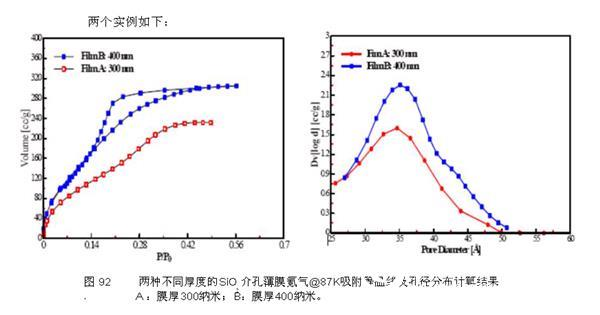Mesoporous silica film (usually referred to as a film material with a thickness of 300 to 900 nm) in sensors, low dielectric films, etc. A wide range of applications are available in many fields. The introduction of mesopores in the film facilitates further reduction of the dielectric constant of the material. It can be said that thin silicon dioxide The dielectric constant of the film is closely related to the pore size distribution and pore volume of the material. Usually, mesopores smaller than 10 nm are used to reduce the film. The dielectric constant can play an important role. Holes larger than 10 nm in the film are often caused by the development and manufacturing of such materials. The cause of device manufacturing failure. However, measuring the pore size distribution and pore volume in such films is quite difficult. The gas adsorption method is 10 nanometers Conventional characterization of the right and left holes. In general, the adsorption of nitrogen, argon and helium at 77.35K or 87.27K can be used to calculate more The specific surface area, pore size, pore distribution and pore volume of the pore material cannot be characterized by conventional nitrogen and argon. this is Since the total pore volume and surface area of ​​the film material are very small, the pressure difference caused by the adsorption is also extremely small. ? Recently, a new method for determining the pore size of thin film materials has been established, and helium gas is used for aperture measurement. This method has been built in 3H-2000 series automatic physical adsorption analyzer. This method is not only applicable to silica-based mesoporous film materials, It is suitable for mesoporous materials with surface oxidizing properties. ? ? ? ? This method chooses to use liquid argon temperature (87K) instead of liquid nitrogen temperature (77K), because: ? 1) The difference in saturated vapor pressure. The saturated vapor pressure (sublimation) of helium at 77K is about 1.6torr, and at 87K it is about 13torr. In the case of a device equipped with a molecular pump and a low pressure sensor, the saturated vapor pressure of 13torr can be pore size analysis, even Microwell analysis (down to 0.7 nm) provides sufficient resolution. ? 2) The mathematical relationship between the physical expression and the pore size change is a prerequisite for the pore size analysis. Research shows that at 77K At the temperature, helium gas will simultaneously undergo capillary condensation and desublimation in the pores. However, only capillary condensation occurs at 87K. ? • When applying this method, the adsorption of helium at liquid argon temperature is first corrected. The calibration process is as follows: 1, using a well-recognized highly ordered mesoporous material as a reference sample (such as MCM-41, SBA-15 or MCM-48) in nitrogen Adsorption measurements were carried out under gas (77K) and argon (87K) conditions, and geometrically shaped pores were calculated by the NLDFT method. Diameter and pore volume (extended to the micropore range). ? 2. Measure the helium (87K) isotherm of the above material and correlate the pore size according to the harvest of the first step. Thus, the film hole The diameter distribution can be obtained by the NLDFT method. ? 3. The density of the liquid phase condensed in the channel can be determined by (a) the pore volume of the known mesoporous material used in the first step and (b) the gas of helium. The amount of adsorption is calculated. The average liquid phase enthalpy density obtained in the test was 2.6 g/cm3, which was in agreement with the theoretical calculation. Then, The total pore volume of the film can be calculated from the density of the liquid phase. Plastic Bottle,Plastic Bamboo Bottle,Plastic Sports Bottle,Plastic Bottle For Drinks Ningbo Auland International Co.,Ltd. , https://www.aulandbottles.com
How to analyze mesoporous silica film with helium (@87K)?